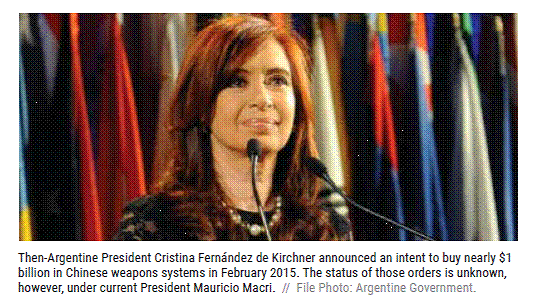Why Is China Selling More Arms in Latin America?
Fecha:2016/09/19 Autor:Q: As recently as 2005, China had been selling next to no armaments or weapons systems in Latin America. But between 2011 and 2015, Venezuela alone purchased $373 million of Chinese weaponry, with other ALBA member states having also secured deals with China to purchase arms, as well as some non-member states, including Peru, The Diplomat reported last month. What accounts for the big increase in Chinese arms sales to Latin America over such a short period? Which global arms suppliers stand to lose the most as a result of this trend? Is the influx in Chinese arms in the region a trend that will last, or will it change along with shifting ideological winds and political leadership? What are the implications of China’s increased arms sales for U.S. security interests in the region?
A: Wu Baiyi, research fellow at the Institute of Latin American Studies of the Chinese Academy of Social Sciences: “China’s arms sales in Latin America are nothing contrary to the current arms control regimes, strictly below the relevant ceilings of specific weapons or destination, as articulated by the Missile Technology Control Regime. It’s also important to note that all arms are defensive, conventional in category and in nature. Purchases of Chinese arms in Latin America occurred in the marketplace as a deal made on the commercial rule, which is that function and price prevail in the end. Purchasing from China is not an ideological consideration, but rather should be attributed to the comparative advantage of Chinese defense products, which accounts for this recent increase in sales in the region. That ALBA member states happened to purchase more arms from China than other Latin American countries may be partially due to their tense relations with neighbors, and with Washington as well. However, Chinese sales do not necessarily have a political or diplomatic meaning. The shift to increased sales in Latin America may reveal that in the future, Chinese firms may become a new competitor in the region’s diversifying arms market, which may affect the existing interest of U.S. counterparts. But for Washington’s geopolitical and security interest, the trend is far less meaningful, because Beijing has no intent to involve itself in such rivalry in the region.”
A: Margaret Myers, director of the China and Latin America Program at the Inter-American Dialogue: “Chinese arms sales to Latin America have increased rather remarkably in recent years, along with China’s arms sales elsewhere in the world. This growth is due in large part to the country’s own effort to grow its military arms and other high-tech industries, which has resulted not only in more weapons exports, but also in the export of increasingly sophisticated military machinery. Latin America nonetheless represents a rather small portion of China’s overall arms sales. According to The Stockholm International Peace Research Institute (SIPRI), from 2010-2014 more than 68 percent of Chinese exports went to just three countries: Pakistan, Bangladesh and Myanmar. As China’s weapons industry continues to grow, U.S. and other arms dealers should expect more competition from China’s burgeoning military weapons industry, although the United States and Russia far outrank China in global sales. In general, China’s ambitions in Latin America should be viewed as primarily economic in nature rather than part of Beijing’s perceived geo-strategic calculus. The region is an attractive market for Chinese exporters of all sorts. Weapons sales to Venezuela and other left-leaning partner nations were largely encouraged by strong government-to-government ties and attractive financing arrangements. It remains to be seen whether new Latin American leaders will be as receptive to Chinese arms deals as some of their predecessors. There is always the risk, of course, that a surge in military sales to Latin American nations, whether by Chinese or other sellers, could fuel regional tensions. The recent development of a China-funded deep space research facility in Argentina generated plenty of concerns in neighboring Brazil.”
A: R. Evan Ellis, research professor of Latin American Studies at the U.S. Army War College Strategic Studies Institute: “Chinese companies have sold limited quantities of low-technology military goods like uniforms and small arms to Latin America for some time. The HN-5 air defense weapons famously sent out of Bolivia before Evo Morales’ 2006 inauguration were Chinese. Hugo Chávez, who provided the breakthrough opportunity for the Chinese, initially bought Russian end items, but later Chinese systems as well, after the United States restricted arms sales to his regime. After Venezuela purchased the Chinese JYL-1 radar, the PRC leveraged Chávez’s relationship with Ecuador’s Rafael Correa to sell that country a similar system, although the deal ended badly. China similarly used Venezuela’s purchase of K-8 aircraft to sell additional K-8s to Bolivia. Within Venezuela, China leveraged its special relationship, convenient financing and low cost to diversify sales to Y-8 and Y-12 transport aircraft, L-15 fighters, Z-9 helicopters and armored vehicles. Doing so arguably concerned Russia’s Rosboronexport, whose aftermarket support, financing and electronics suites (in some cases) compares unfavorably to the Chinese. Peru’s purchase of Chinese trucks and Type 90-B self-propelled artillery over Russian competition suggests that China continues to make inroads in the region, partly at Russia’s expense, in and beyond ALBA member states. The perceived low-quality of Chinese equipment, and the United States’ response, are concerns for many Latin American militaries. Yet as with Chinese cars, motorcycles and cellphones, China-based defense companies will continue to make progress as they improve quality and performance, leverage internal financing and government support, and as their executives become more adept at working the region’s arms market.”
Aviso jurídico | Enlace con nosotros | Respuestas | Descárguese | Directorio |
Derecho reservado: Instituto de América Latina,Academia de China de Ciencias Sociales.
Apoyo técnico: Corporación Tecnológica Internet Haishijingwei de Beijing S.A.
Nuestra sede: Calle Zhangzi zhonglu, No. 3, Barrio Dongcheng, Beijing, P.O. Box 1104, 100007, Beijing, China.
Buscar Fax: 010-64014011 E-mail: ilas@cass.org.cn
